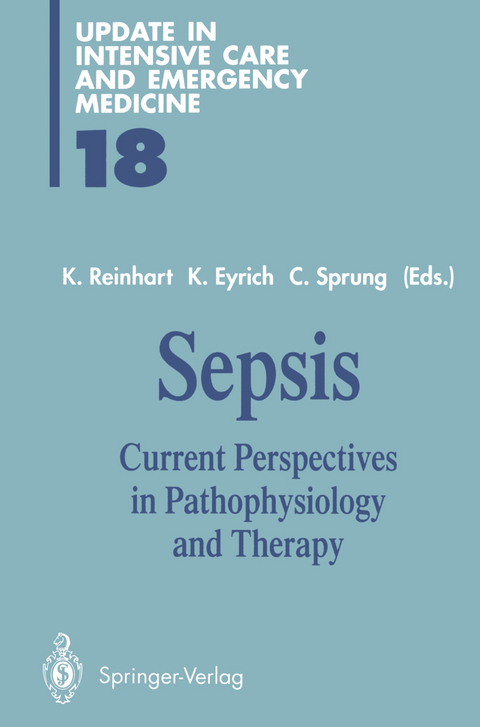
Sepsis
Springer Berlin (Verlag)
978-3-642-85038-7 (ISBN)
I. Definition/Prognosis.- Sepsis and Septic Shock: Update on Definitions.- Clinical Manifestations and Prognostic Indicators in Sepsis.- What Determines Prognosis in Sepsis? Evidence for a Comprehensive Individual Patient Risk Assessment Approach to the Design and Analysis of Clinical Trials.- A Scoring System for Multiple Organ Dysfunction Syndrome.- II. Pathogenesis.- Endotoxemia and Sepsis: Important Roles for Lipopolysaccharide Binding Protein and CD14 in Endotoxin Signal Transduction.- Bacterial Exotoxins and Sepsis.- Bacterial Translocation: Myth versus Reality.- Tumor Necrosis Factor and Other Cytokines in Septic Syndrome.- Role of Oxygen Free Radicals in the Pathophysiology of Sepsis.- III. Pathophysiology.- Cardiocirculation in Sepsis.- A Current View of Oxygen Supply Dependency.- Sepsis and Nutritional Blood Flow.- Endothelial Cell Function in the Critically Ill.- Sepsis and Cellular Metabolism.- IV. Monitoring.- Monitoring of O2 Transport and Tissue Oxygenation in Septic Shock.- V. Therapy.- Sepsis-Related Problems in Pediatric Patients.- Definitions and Therapy of Sepsis.- Role of Surgical Intervention in the Prevention and Therapy of Sepsis.- Antibacterial Treatment of Sepsis.- Diagnostic and Therapeutic Approach in Invasive Fungal Infections of Intensive Care Unit Patients.- Fluid Therapy in Sepsis.- Influence of Catecholamines on Regional Perfusion and Tissue Oxygenation in Septic Shock Patients.- Metabolic Changes in Sepsis - Can the Host Response be Influenced Metabolically?.- VI. New Therapeutic Approaches.- Is there a Place for Monoclonal Antibodies Against Endotoxin in the Therapy of Sepsis?.- Endotoxin in Septic Shock.- Tumour Necrosis Factor as a Therapeutic Target in Sepsis.- Tumor Necrosis Factor-Neutralization with a Specific MonoclonalAntibody.- Cardiovascular Effects of Repeated Administration of the F(ab')2 Fragment of an Anti-tumor Necrosis Factor-? Monoclonal Antibody in Patients with Severe Sepsis.- Modulating Effects of Pentoxifylline on Cytokine Release Syndromes.- The Treatment of Sepsis with Interleukin-1 Receptor Antagonist.- The Function and Potential Therapeutic Value of Lipopolysaccharide Binding Protein During Gram- Negative Sepsis: Recombinant Expression and Promoter Studies.- Platelet-Activating Factor: Pathophysiological Changes and Therapeutic Implications in Sepsis.- Potential of Oxyradical Scavengers in the Therapy of Sepsis.- N-Acetylcysteine in Sepsis.- Immunoaugmentation: A Contribution to Prophylaxis and Treatment of Sepsis?.- What Is Certain in the Treatment with Immunoglobulins?.- Arachidonic Acid Metabolism in Sepsis: What is the Role of Cyclooxygenase Inhibition?.- Improvement of Monocyte Function A New Therapeutic Approach?.- From Localized Angioedema to Generalized Capillary Leak Syndrome.- Potential for Gene Therapy in the Treatment of Sepsis.- VII. Specific Therapeutic Aspects.- Step-by-Step Treatment of Acute Respiratory Distress Syndrome.- Perfluorocarbons as an Alternative Respiratory Medium.
| Erscheint lt. Verlag | 12.2.2012 |
|---|---|
| Reihe/Serie | Update in Intensive Care and Emergency Medicine |
| Zusatzinfo | XVI, 571 p. |
| Verlagsort | Berlin |
| Sprache | englisch |
| Maße | 155 x 235 mm |
| Gewicht | 878 g |
| Themenwelt | Medizin / Pharmazie ► Medizinische Fachgebiete ► Intensivmedizin |
| Schlagworte | Definition • Diagnose • Diagnosis • Pathophysiologie • pathophysiology • Physiology • Sepsis • Sepsis / Blutvergiftung • shock • Therapie • therapy |
| ISBN-10 | 3-642-85038-3 / 3642850383 |
| ISBN-13 | 978-3-642-85038-7 / 9783642850387 |
| Zustand | Neuware |
| Haben Sie eine Frage zum Produkt? |
aus dem Bereich


